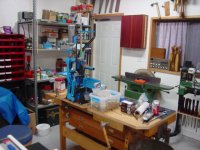Bkreutz
US Veteran
So the gist of my question was how much I really need auto feeders. Sounds like the bullet feeders are more trouble than they are worth for my application. If I use a shell feeder, than that would need tinkering with every caliber change over, and use one of the five die slots. Right now I'm looking at reloading for bulk on .45 auto, .38 sp, and .204 Ruger. I'll likely do runs of each, 1000 rnds or so, then lay off that rnd until I get low. With no auto shell feeder, I'm looking at moving my left arm twice per evolution (insert a shell, insert a bullet) of the right hand lever. With the shell loader, once with the left arm per evolution. The other consideration is using up a die space on the 5 station models. If reloading handgun ammo, what would be the standard die configuration? I would like to include a powder check die in that.
The case feeder does not take up one of the die slots, it's actually outside of the die area (the case is pushed into position one which is the decap/size die). When I got my 650 I didn't get the auto case feeder on purpose so my wife would have something to get me for birthday/Christmas (after 37 years you run out of ideas

